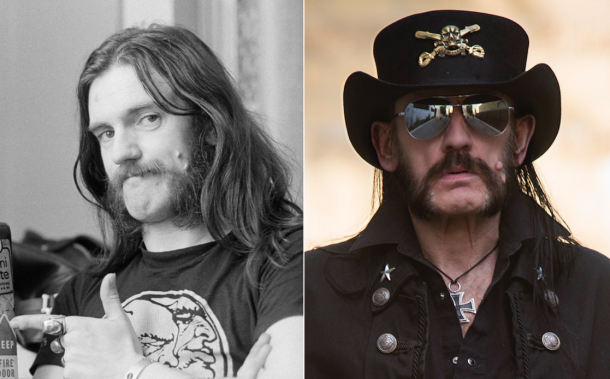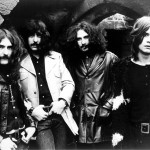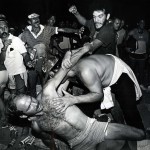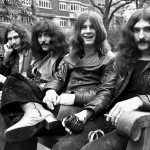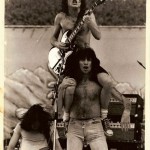Motorhead’s Lemmy Kilmister Through Out The Decades Photo Montage Over 5 Decades
Ian Fraser Kilmister (24 December 1945 – 28 December 2015), known as Lemmy, was an English musician, singer and songwriter who founded and fronted the rock band Motörhead. His music was one of the foundations of the heavy metal genre. He was known for his appearance (including his friendly mutton chops) and his distinctive gravelly voice. Alongside his music career, he also had many minor roles in film and television.
Lemmy was born in Stoke-on-Trent and grew up in North Wales. He was influenced by rock and roll and the early Beatles, which led to him playing in several rock groups in the 1960s, including the Rockin’ Vickers. He worked as a roadie for Jimi Hendrix and the Nice, before joining the space rock band Hawkwind in 1971, singing lead on their hit “Silver Machine”. After being fired from Hawkwind, he founded Motörhead as lead singer, bassist, songwriter and frontman. Motörhead’s success peaked in 1980 and 1981 and included the hit single “Ace of Spades” and the top charting live album No Sleep ’til Hammersmith. Lemmy continued to record and tour regularly with Motörhead until his death in December 2015 in Los Angeles, where he had lived from 1990.
Aside from his musical activities, Lemmy was well known for his hard-living lifestyle and regular consumption of alcohol and amphetamines.
CLICK HERE FOR ALL OF OUR ARTICLES ON LEMMY AND MOTORHEAD
Posted by SofaKingCoolOnline.com on Friday, February 26, 2016
Lemmy was born on Christmas Eve in the Burslem area of Stoke-on-Trent, Staffordshire. When Lemmy was three months old, his father, an ex-Royal Air Force chaplain and concert pianist (who died within six months of Kilmister’s stepfather, in 2011) separated from his mother. His mother and grandmother moved to Newcastle-under-Lyme, then to Madeley. When Lemmy was 10, his mother married former footballer George Willis, who already had two older children from a previous marriage, Patricia and Tony, with whom Lemmy did not get along.
The family moved to a farm in Benllech on Anglesey, with Lemmy later commenting on his time there, that “funnily enough, being the only English kid among 700 Welsh ones didn’t make for the happiest time, but it was interesting from an anthropological point of view.” He attended Sir Thomas Jones’ School in Amlwch, where he was nicknamed Lemmy. It was later suggested by some that the name originated from the phrase “lemmy [lend me] a quid till Friday” because of his alleged habit of borrowing money from people to play slot machines, although Lemmy himself claimed that he didn’t know the origin of the name. He soon started to show an interest in rock and roll music, girls and horses.
By the time he left school his family had moved to Conwy, still in northern Wales. There he worked at menial jobs including one in the local Hotpoint electric appliance factory, while also playing guitar for local bands, such as the Sundowners, and spending time at a horse-riding school. Lemmy saw the Beatles perform at the Cavern Club when he was 16, and then learned to play along on guitar to their first album Please Please Me. He also admired the sarcastic attitude of the group, particularly that of John Lennon.
At the age of 17 he met a holidaying girl called Cathy. He followed her to Stockport, where she eventually had his son Sean, who was put up for adoption. In the 2010 documentary film Lemmy, Lemmy mentions having a son whose mother has only recently “found him” and “hadn’t got the heart to tell him who his father was”, indicating the boy – perhaps Sean – was given up for adoption.
In Stockport, Lemmy joined local bands the Rainmakers and then the Motown Sect who played northern clubs for three years. In 1965 he joined the Rockin’ Vickers who signed a deal with CBS, released three singles and toured Europe, reportedly being the first British band to visit the Socialist Federal Republic of Yugoslavia. The Rockin’ Vickers moved to Manchester, where they lived together in a flat. There Lemmy got involved with a girl named Tracy who bore him a son, Paul Inder. Lemmy did not have any involvement with him until the boy was six.
Leaving the Rockin’ Vickers, Lemmy moved to London in 1967. He shared a flat with Noel Redding, bassist of the Jimi Hendrix Experience, and with Neville Chesters, their manager. He got a job as a roadie for the band. In 1968 he joined the psychedelic rock bandSam Gopal under the name Ian Willis and recorded the album Escalator released in 1969.
After meeting Simon King in a Chelsea shopping centre in 1969, he joined the band Opal Butterfly; but the group soon folded, having failed to raise enough interest with their singles.
In August 1971 Lemmy joined the space rock band Hawkwind, who were based in Ladbroke Grove, London, as a bassist and vocalist. He had no previous experience as a bass guitarist, and was cajoled into joining immediately before a benefit gig in Notting Hill by bandmate Dik Mik in order to have two members who enjoyed amphetamines. He quickly developed a distinctive style that was strongly shaped by his early experience as a rhythm guitarist, often using double stops and chords rather than the single note lines preferred by most bassists. His bass work was a fundamental part of the Hawkwind sound during his tenure, perhaps best documented on Space Ritual. He also provided the lead vocals on several songs, including the band’s biggest UK chart single, “Silver Machine”, which reached No. 3 in 1972.
In 1975 Lemmy was arrested at the Canada/US border in Windsor, Ontario, on drug possession charges; he spent five days in jail but was released without charge. Nonetheless he was fired from Hawkwind
After Hawkwind, Lemmy formed a new band called “Bastard” with guitarist Larry Wallis (former member of the Pink Fairies, Steve Took’s Shagrat and UFO) and drummer Lucas Fox. Lemmy and Took were friends, and Took was the stepfather to Lemmy’s son Paul. When his manager informed him that a band by the name of “Bastard” would never get a slot on Top of the Pops, Lemmy changed the band’s name to “Motörhead” – the title of the last song he had written for Hawkwind.
Soon after, both Wallis and Fox were replaced with guitarist “Fast” Eddie Clarke and drummer Phil “Philthy Animal” Taylor and with this line-up the band began to achieve success. Lemmy’s guttural vocals were unique in rock at that time, and were copied during the time when punk rock became popular. The band’s sound appealed to Lemmy’s original fans and, eventually, to fans of punk. Lemmy asserted that he generally felt more kinship with punks than with metalheads; he even played with the Damned for a handful of gigs when they had no regular bassist. The band’s success peaked in 1980 and 1981 with several UK chart hits, including the single “Ace of Spades”, which remained a crowd favourite throughout the band’s career, and the UK No. 1 live album No Sleep ’til Hammersmith. Motörhead became one of the most influential bands in heavy metal. Their – and Lemmy’s – last live performance was in Berlin on 11 December 2015
Dave Grohl, on his Probot website, describes musicians with whom he has worked. In his entry for Lemmy he wrote:
We recorded his track in Los Angeles in maybe two takes about a year and a half ago. Until then I’d never met what I’d call a real rock ‘n’ roll hero before. Fuck Elvis and Keith Richards, Lemmy’s the king of rock ‘n’ roll – he told me he never considered Motörhead a metal band, he was quite adamant. Lemmy’s a living, breathing, drinking and snorting fucking legend. No one else comes close.
In a Channel 4 documentary called Motörhead: Live Fast, Die Old, broadcast on 22 August 2005, it was claimed that Lemmy had “bedded” in excess of 2,000 women. Lemmy stated: “I said more than a thousand, the magazine made two thousand of it.” Maxim had Lemmy at number 8 on its top ten “Living Sex Legends” list, as they claimed that he had slept with around 1,200 women. In the documentary he explained that while in school he noticed a pupil who had brought a guitar to school and had been “surrounded by chicks”. His mother had a guitar, which he then took to school, even though he could not play, and was himself surrounded by girls.
Lemmy is one of the characters in the book Sex Tips from Rock Stars by Paul Miles.
Lemmy was well known for his intake of alcohol. The documentary Live Fast Die Old stated that he drank a bottle of Jack Daniel’s every day and had done so since he was 30 years old. In 2013, Lemmy stopped drinking Jack Daniel’s for health reasons.
During his time with Hawkwind he developed an appetite for amphetamines and LSD, particularly the former. Before joining Hawkwind, he recalled Dik Mik, a former Hawkwind sound technician, visiting his squat in the middle of the night and taking speed with him. They became interested in how long “you could make the human body jump about without stopping”, which they did for a few months, until Mik ran out of money and wanted to return to Hawkwind, taking Lemmy with him.
I first got into speed because it was a utilitarian drug and kept you awake when you needed to be awake, when otherwise you’d just be flat out on your back. If you drive to Glasgow for nine hours in the back of a sweaty truck you don’t really feel like going onstage feeling all bright and breezy … It’s the only drug I’ve found that I can get on with, and I’ve tried them all – except smack [heroin] and morphine: I’ve never “fixed” anything.
In November 2005 he was invited to the National Assembly for Wales as a guest speaker by Tory member William Graham. He was asked to express his views on the detrimental effects of drugs, and called for the legalisation of heroin. He stated that legalisation would eradicate the drug dealer from society and generate money from its taxation, however hard this would be to accept.
Lemmy collected German military regalia; he had an Iron Cross encrusted on his bass, which led to accusations of Nazi sympathies. He stated that he collected the memorabilia because he liked the way it looked, and considered himself an anarchist or libertarian. Lemmy was against religion, government and established authority, and in 2011 identified as agnostic, saying, “I can find out when I die. I can wait. I’m not in a hurry.” Jeff Hanneman, the founder of the thrash metal band Slayer, befriended Lemmy due to their shared fondness for collecting Nazi memorabilia. According to Keith Emerson’s autobiography, Lemmy gave him two of his Hitler Youth knives during his time as a roadie for the Nice. Emerson used these knives many times as keyholders when playing the Hammond organ during concerts with the Nice and Emerson, Lake & Palmer before destroying them. Lemmy defended his collection by saying that if his black girlfriend had no problem with it, nobody else should.
From 1990 Lemmy lived in Los Angeles, California, most recently in a two-room apartment two blocks away from his favourite hangout, the Rainbow Bar and Grill.
As he grew older he used less alcohol and drugs as he suffered from diabetes and hypertension. In 2013 he had an implantable cardioverter-defibrillator fitted. He referred to his continuing drug use as “dogged insolence in the face of mounting opposition to the contrary”.
On 28 December 2015, four days after his 70th birthday, Lemmy died at his home in Los Angeles at 16:00 PST, from an “extremely aggressive cancer”. Motörhead announced his death on their official Facebook page later that day. According to the band, his cancer had only been diagnosed two days prior to his death. His manager, Todd Singerman, later revealed:
He (Lemmy) gets home (from tour), we have a big birthday party for him at the Whisky A Go Go. His friends came down and played. Two days later I could tell he wasn’t feeling good so we took him to the hospital, they release him, then after the brain scan they found the cancer in his brain and his neck… The doctor comes with the result a couple of days later and says… it’s terminal.
Lemmy’s doctor had given him between two and six months to live. Although his manager had planned to keep the news private until his eventual death, Lemmy strongly encouraged him to make the diagnosis public in early 2016, but he died before a press release could be drafted. Following the terminal diagnosis, Rainbow Bar owner Mikael Maglieri brought a video game machine that Lemmy was fond of playing at the establishment over to his apartment so he could continue playing it from his bedside.
Lemmy’s memorial service took place at Forest Lawn Memorial Park, Hollywood on 9 January 2016. The service was streamed live over YouTube with more than 230,000 people logging on to watch, while others gathered at the Rainbow.
An autopsy was performed, and the causes of death were shown to be prostate cancer, cardiac arrhythmia, and congestive heart failure
Official Motörhead Lemmy Kilmister Motörhead Photo Montage Over 5 Decades, Some Pretty Rare Photo's Of Lemmy
Posted by SofaKingCoolOnline.com on Friday, February 26, 2016

